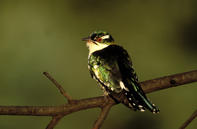
Name
Diderick cuckoo - Chrysococcyx caprius
Diderick Cuckoo Appearance
The diderick cuckoo is one of the smaller cuckoos, with a length of around 19 cm. The male has glossy green upperparts and head, with a copper sheen on its back. The underparts are a dirty white, in colour. A broken white eye stripe, a red eye and dark bill. This cuckoo has white wing spots and green bars on its flanks.
The female diderick cuckoo has similar colouring as the male, but shows coppery barring on the flanks.
Diet
The diderick cuckoo feeds mainly on caterpillars, but will feed on other insects.
Diderick Cuckoo Breeding
The diderick cuckoo is a brood parasite and parasites closed grass nests. The female lays either one or two eggs in the host nest and will remove the host egg before laying her own. The diderick’s eggs are larger than the host eggs, but it will match the shape and colour of the host eggs.
The diderick cuckoo will parasite a wide range of species, especially bishops, sparrows and weavers.
Diderick Cuckoo Behaviour
The diderick cuckoo gets its name from its call, which is 5 to 7 plaintive high pitched notes; dee-dee-deederik. It is the male that calls, advertising his presence to any available females. This cuckoo is heard far more often than it is seen.
Threats
None.
Diderick Cuckoo Distribution and Habitat
Diderick cuckoos are intra-African migrants that arrive in Southern Africa from Central or East Africa. They spend around 6 months in Southern Africa and depart around April. Diderick cuckoos are found in a wide range of habitats, but are often found near weaver colonies. The diderick cuckoo can be found throughout South Africa, except the very arid Karoo region.